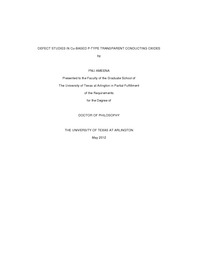
ATTENTION: The works hosted here are being migrated to a new repository that will consolidate resources, improve discoverability, and better show UTA's research impact on the global community. We will update authors as the migration progresses. Please see MavMatrix for more information.
Show simple item record
| dc.contributor.author | Ameena, Fnu | en_US |
| dc.date.accessioned | 2012-07-25T19:09:24Z | |
| dc.date.available | 2012-07-25T19:09:24Z | |
| dc.date.issued | 2012-07-25 | |
| dc.date.submitted | January 2012 | en_US |
| dc.identifier.other | DISS-11570 | en_US |
| dc.identifier.uri | http://hdl.handle.net/10106/11086 | |
| dc.description.abstract | Among other intrinsic open-volume defects, copper vacancy (VCu) has been theoretically identified as the major acceptor in p-type Cu-based semiconducting transparent oxides, which has potential as low-cost photovoltaic absorbers in semi-transparent solar cells. A series of positron annihilation experiments with pure Cu, Cu2O, and CuO presented strong presence of VCu and its complexes in the copper oxides. The lifetime data also showed that the density of VCu was becoming higher as the oxidation state of Cu increased which was consistent with the decrease in the formation energy of VCu. Doppler broadening measurements further indicated that electrons with low momentum made more contribution to the contributed as pure Cu oxidizes to copper oxides.The metastable defects are known to be generated in Cu2O upon illumination and it has been known to affect the performance of Cu2O-based hetero-junctions used in solar cells. The metastable effect was studied using positron annihilation lifetime spectroscopy and its data showed the change in the defect population upon light exposure and the minimal effect of light-induced electron density increase in the bulk of materials to the average lifetime of the positrons. The change in the defect population is concluded to be related to the dissociation and association of VCu - VCu complexes. For example, the shorter lifetime under light was ascribed to the annihilation with smaller size vacancies, which explains the dissociation of the complexes with light illumination. Doppler broadening of the annihilation was independent of light illumination, which suggested that the chemical nature of the defects remained without change upon their dissociation and association - only the size distribution of copper vacancies varied. The delafossite metal oxides, CuMIIIO2 are emerging wide-bandgap p-type semiconductors. In this research, the formation energies of structural vacancies are calculated using Van Vechten cavity model as an attempt to study the effect of the size of the MIII cation in the delafossites starting from Cu2O. Comparison of the formation energies between Cu2O and delafossite oxides clearly showed that the equilibrium concentration of the vacancies depended strongly on the structural parameters varied by the presence of different MIII cations. In particular, the size of the MIII cation greatly influenced the defect formation energies of VCu. It was observed from our calculations, as the size increases the formation energy decreases. | en_US |
| dc.description.sponsorship | Jin, Michael | en_US |
| dc.language.iso | en | en_US |
| dc.publisher | Physics | en_US |
| dc.title | Defect Studies In Cu-based P-type Transparent conducting Oxides | en_US |
| dc.type | Ph.D. | en_US |
| dc.contributor.committeeChair | Jin, Michael | en_US |
| dc.degree.department | Physics | en_US |
| dc.degree.discipline | Physics | en_US |
| dc.degree.grantor | University of Texas at Arlington | en_US |
| dc.degree.level | doctoral | en_US |
| dc.degree.name | Ph.D. | en_US |
Files in this item
- Name:
- Ameena_uta_2502D_11570.pdf
- Size:
- 5.705Mb
- Format:
- PDF
This item appears in the following Collection(s)
Show simple item record


